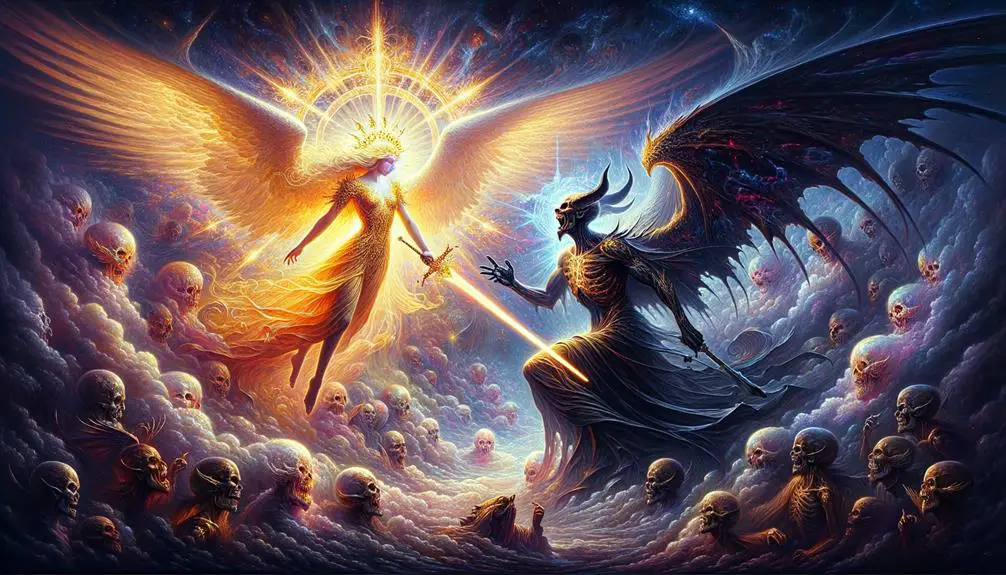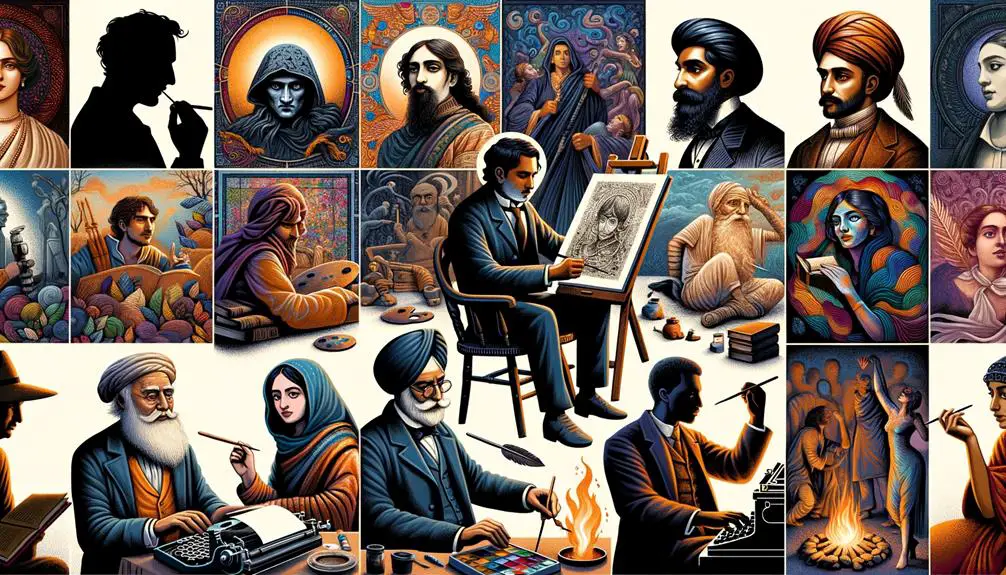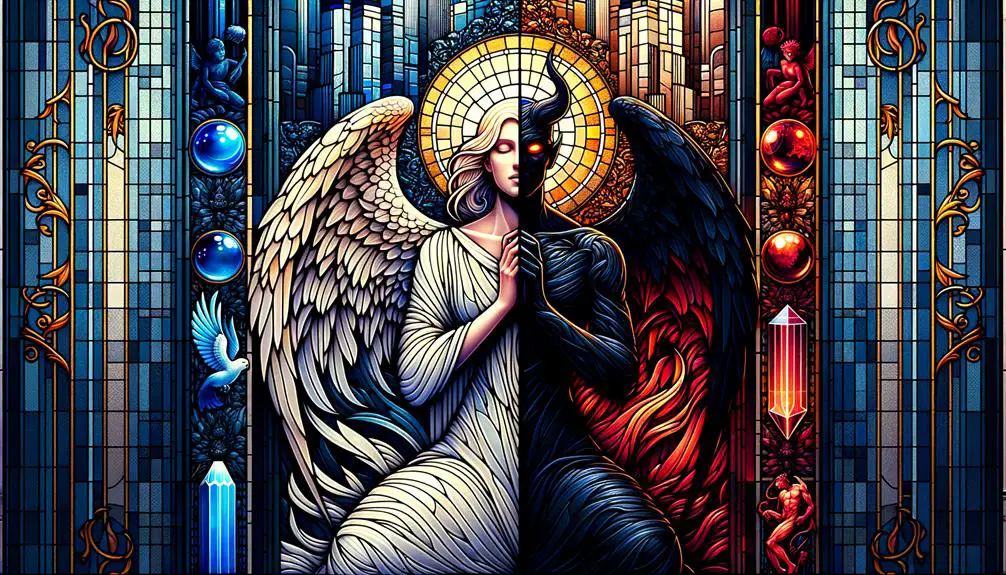Yielding insights into the battle between good and evil, Belial's enigmatic presence in the Bible intrigues and beckons deeper exploration.

Who Is Belial in the Bible
Have you ever wondered who Belial is in the biblical context?
You're not alone in your curiosity. Originating from the Hebrew Bible, Belial is often associated with lawlessness and evil, presenting a complex figure whose interpretation varies widely across different religious texts.
In Christianity, his role expands, embodying opposition to divine order. But what makes Belial particularly fascinating are not just his deeds or the mythology surrounding him, but how his presence has been interpreted and reinterpreted through ages, influencing literature, art, and modern perceptions.
Unraveling the enigma of Belial offers insights into the battle between good and evil, a theme as old as time itself.
Key Takeaways
- Belial represents chaos, lawlessness, and rebellion against divine virtues in biblical narratives.
- Initially a symbol of worthlessness, Belial evolves into a personification of evil in Hebrew Scriptures.
- In Christian doctrine, Belial is portrayed as a demonic figure in direct opposition to God's will.
- Belial's role in religious texts symbolizes the eternal struggle between good and evil.
The Origin of Belial

Belial's origins, deeply embedded in biblical texts, reveal a complex figure whose name has evolved over time, reflecting shifts in theological and moral interpretations. You're diving into a realm where Belial's etymology plays a crucial role in understanding his transformation from a term denoting worthlessness to a personification of evil. The term itself, derived from Hebrew, combines “beli” (without) and “ya'al” (value), painting a picture of utter desolation and moral bankruptcy.
In your exploration, you'll find that comparative mythology sheds light on how Belial's characteristics parallel entities in other ancient belief systems. This comparative analysis isn't just about drawing parallels but understanding the cultural and theological cross-pollination that influenced how entities like Belial were understood and depicted. For instance, figures akin to Belial in Mesopotamian or Canaanite mythology often embody chaos, disorder, or are adversaries to the gods, highlighting a universal archetype of opposition that transcends individual mythologies.
Your scholarly journey reveals that Belial's narrative isn't static but fluid, reflecting the changing landscapes of belief systems and what they deem as representing moral and spiritual decay. This evolution in interpretation and role underscores the complexity of ancient texts and the entities within them, suggesting that Belial's story is more than a tale of villainy; it's a mirror to the changing perspectives on evil and morality over centuries.
This detailed analysis, grounded in Belial's etymology and comparative mythology, offers a nuanced understanding of his origins, challenging simplistic interpretations and inviting a deeper reflection on the nature of evil as depicted in ancient texts.
Belial in Hebrew Scriptures
Having explored the etymological and comparative mythological roots of Belial, we now turn our attention to the figure's portrayal and significance within the Hebrew Scriptures. You'll find that Belial's etymology serves as a foundation for understanding his depiction in these ancient texts. Initially, the term 'Belial' denoted worthlessness or lawlessness, characteristics that are vividly attributed to this figure in scriptural narratives.
In the Hebrew Scriptures, Belial isn't personified as a singular demonic entity until the texts begin to approach the Hellenistic period. Before this, references to Belial are largely symbolic, representing general wickedness or adversaries of God's people without embodying a singular, malevolent being. However, in the Apocryphal texts, particularly those found among the Dead Sea Scrolls, Belial's role is significantly expanded, portraying him as a leader of darkness opposed to the forces of light.
To paint a picture of Belial within the Hebrew Scriptures and Apocryphal writings:
- *Belial's etymology* suggests a transition from a concept of worthlessness to a personification of evil.
- References to Belial pre-Hellenistic period indicate societal and moral decay rather than a demonic presence.
- In *Apocryphal texts*, Belial assumes a more defined role as the antagonist, leading forces against godliness.
- Belial symbolizes the ultimate opposition to divine order, challenging the faithful and tempting them away from their covenant with God.
- The evolution of Belial's character in these texts reflects a growing dualistic worldview within Jewish thought, emphasizing the struggle between good and evil.
This analysis underscores Belial's multifaceted role and the complexity of his development within scriptural narratives, laying a foundation for how he's later understood in Christian theology.
Belial's Role in Christianity

In Christian doctrine, Belial transitions from a symbol of lawlessness to a more distinctly demonic figure, embodying opposition to divine will with notable clarity. This evolution reflects Christianity's broader cosmological narrative, where forces of good and evil are more personalized and dramatized.
You'll find that, unlike in Hebrew scriptures, Belial's role within Christian texts, particularly in apocryphal tales, extends his persona into realms of explicit moral and spiritual antagonism.
Through these stories, you're introduced to an intricate portrayal of Belial. Notably absent, however, is any notion of Belial's repentance. Unlike some figures in Christian lore who navigate between redemption and damnation, Belial remains steadfastly opposed to the divine order. This constancy underscores his role as an irredeemable adversary within Christian theology, a stark embodiment of resistance against God's sovereignty.
Apocryphal tales further enrich your understanding of Belial's place within Christian thought. These narratives, while not canonical, offer detailed insights into how early Christians perceived the battle between good and evil. Belial, within these stories, is often depicted orchestrating chaos, seducing humans into sin, and standing in direct opposition to the forces of righteousness. Such depictions amplify his significance as a powerful and malevolent entity, whose very existence challenges the faithful to adhere more closely to divine commandments.
Symbolism and Characteristics
You'll find that Belial's symbolic meanings intertwine with his defining characteristics, embodying chaos and moral decay in the biblical narrative.
His portrayal as a figure of lawlessness and opposition underscores a complex symbolism that's crucial for understanding biblical themes of good versus evil.
This analysis allows you to grasp the nuanced roles that Belial plays in conveying deeper moral and theological lessons within the scripture.
Belial's Symbolic Meanings
Belial's symbolic meanings in biblical texts encapsulate themes of wickedness, chaos, and rebellion, embodying the antithesis of divine virtues and order. Delving into Belial's etymology reveals a name often translated as 'worthlessness' or 'lawlessness,' highlighting an inherent opposition to societal and moral codes. Apocalyptic associations further paint Belial as a harbinger of destruction and a pivotal figure in eschatological narratives, where ultimate battles between good and evil unfold.
- *Lawlessness*: Represents a complete disregard for divine and moral laws.
- *Chaos*: Symbolizes the disorder and confusion Belial introduces into creation.
- *Rebellion*: Reflects active opposition against divine authority.
- *Wickedness*: Embodies the essence of evil and moral depravity.
- *Apocalyptic figure*: Marks Belial as a key player in end-times prophecies, emphasizing his role in the ultimate confrontation between good and evil.
Defining Characteristics
Delving deeper into the figure of Belial, we uncover defining characteristics that fuse symbolism with tangible traits, painting a complex portrait of this biblical antagonist. Belial is often depicted as embodying the epitome of lawlessness and moral decay, a representation that might overshadow misunderstood attributes hinting at a nuanced narrative.
Scholars argue that the notion of Belial's redemption, though controversial, introduces a layer of complexity to his character, suggesting possibilities of transformation and repentance previously unexplored. This perspective challenges traditional interpretations, inviting a reevaluation of Belial's role within biblical texts.
It's essential to consider these characteristics not just as mere historical or literary constructs but as reflective of broader theological debates surrounding the nature of evil, redemption, and the capacity for change.
Belial Versus Archangels

In biblical narratives, Belial often stands in stark contrast to the archangels, embodying the antithesis of their divine virtues and missions. You're drawn into a world where the battleground isn't just the heavens and the earth, but also the hearts and minds of humanity. Belial's motivations are deeply rooted in rebellion, chaos, and the undermining of divine order, setting the stage for numerous angelic confrontations. These encounters aren't merely physical battles but are also ideological clashes, pitting deceit against truth, despair against hope, and darkness against light.
To paint a picture for you:
- Belial endeavors to sow discord among humans and angels, directly opposing the archangels' mission of harmony and unity.
- Whereas archangels are messengers of God's will, Belial spreads lies and manipulates truths to lead the righteous astray.
- In their interactions, archangels exhibit unwavering loyalty to divine commands, starkly contrasting with Belial's challenge to divine authority.
- Belial's presence is often marked by a palpable sense of corruption and moral decay, which the archangels tirelessly work to cleanse and redeem.
- The ultimate goal of Belial is to usurp power and establish a dominion characterized by despair and bondage, a direct affront to the liberation and salvation offered by the archangels.
This analysis reveals the depth of Belial's antagonism toward the archangels, highlighting the cosmic struggle between good and evil, order and chaos, that defines much of the biblical narrative.
Interpretations Across Cultures
How do various cultures interpret the figure of Belial, and what does this reveal about their understanding of evil and morality? The etymology of Belial, deriving from the Hebrew term "Beli ya'al," essentially means "without value" or "wickedness," offering a foundational perspective on how this figure is aligned with moral degradation across cultures. This analysis delves into the cross-cultural rituals and interpretations, shedding light on the multifaceted views of Belial.
Culture |
Interpretation of Belial |
Impact on Moral Understanding |
|---|---|---|
Jewish |
An embodiment of evil and lawlessness, influencing individuals to sin against God. |
Highlights the struggle between following God's law and succumbing to moral corruption. |
Christian |
A symbol of ultimate evil, often associated with the devil or Satan, representing opposition to divine will. |
Reflects the binary of good versus evil, emphasizing the importance of moral choice and redemption. |
Occult |
A figure of liberation and personal freedom, challenging traditional moral constraints. |
Posits morality as subjective, encouraging individual exploration beyond conventional good and evil. |
This table illustrates the diverse interpretations of Belial, ranging from a strict embodiment of wickedness to a symbol of liberation. The Belial etymology anchors these views in a concept of valuelessness, which cultures either resist or embrace in their moral frameworks. Cross-cultural rituals involving Belial further underscore these interpretations, whether through acts of rejection and exorcism in Christian traditions or through ceremonies celebrating autonomy and personal power in occult practices. Through these lenses, Belial emerges not just as a figure of evil, but as a catalyst for examining the boundaries of morality and ethics across cultures.
Influences on Literature and Art

You'll find that Belial's presence in classic literature often serves as a symbol for moral decay and the embodiment of evil, reflecting the character's biblical roots.
In visual art, artists interpret Belial through a variety of lenses, ranging from medieval iconography to modern abstract representations, each offering a unique perspective on his influence.
Lastly, modern cultural references to Belial further illustrate his enduring relevance, appearing in various forms across media to explore themes of temptation, chaos, and the struggle between good and evil.
Depictions in Classic Literature
Belial's depiction in classic literature has profoundly influenced the themes and characterizations within both literary and artistic realms. This figure's portrayal, rich in Gothic representation and allegorical uses, provides a multifaceted lens through which to explore the depths of human and supernatural interaction.
- Gothic representation manifests through Belial's embodiment of darkness and chaos, serving as a catalyst for exploring human fears and moral dilemmas.
- Allegorical uses of Belial illustrate the struggle between good and evil, offering profound insights into moral and philosophical debates.
- Belial often personifies temptation and vice, challenging characters' moral compasses and personal growth.
- In narratives, Belial's influence is a test of character strength, resilience, and redemption.
- Literary depictions of Belial contribute to the archetype of the fallen angel, enriching the tapestry of symbolic religious and mythological storytelling.
Visual Art Interpretations
Numerous visual art interpretations of Belial have significantly influenced both the literary and artistic landscapes, offering unique perspectives on themes of morality, chaos, and redemption. Artists have employed color symbolism to depict Belial, using dark, ominous hues to symbolize evil and lighter shades to suggest the possibility of redemption or divine intervention. This use of color not only enhances the narrative but also adds a layer of emotional depth, inviting viewers to engage with the artwork on a more profound level.
Artistic freedoms have allowed creators to explore and express the complexities of Belial's character, often blending traditional biblical elements with contemporary motifs to challenge viewers' perceptions. Through these visual representations, artists have contributed to a richer, more nuanced understanding of Belial, expanding beyond the written word to explore the essence of moral ambiguity and redemption.
Modern Cultural References
In modern culture, Belial's influence permeates literature and art, reflecting a profound impact on contemporary interpretations of morality and chaos. This figure's complex nature has inspired a variety of representations, each exploring different facets of his mythos. Here's how you'll find Belial's presence today:
- Video games often portray him as a formidable antagonist, challenging players to confront themes of corruption and redemption.
- Pop music references Belial to explore struggles between good and evil, using his image to symbolize rebellion.
- Modern novels feature characters inspired by Belial, delving into the psychology of temptation and moral ambiguity.
- Films and TV series use Belial as a metaphor for chaos, examining the consequences of societal and personal downfall.
- Visual artists incorporate Belial to critique or explore contemporary issues, using his symbolism to provoke thought on morality.
Modern Perceptions of Belial

Today, perceptions of Belial vary widely, reflecting a complex evolution from ancient texts to contemporary interpretations. In the digital age, Belial memes have emerged as a peculiar yet significant aspect of how modern society engages with this biblical figure. These memes often use humor to explore deeper themes of rebellion, autonomy, and moral ambiguity, bridging ancient religious narratives with current societal issues. Such depictions not only demonstrate the versatility of Belial as a symbol but also highlight the fluidity of mythological characters in the digital era, where they're reinterpreted and repurposed across various media platforms.
Moreover, Belial has been recast in sociopolitical allegories, serving as a mirror to contemporary societal and political dilemmas. Scholars and critics alike delve into how narratives surrounding Belial can be seen as allegorical representations of the struggle against corrupt authority, systemic evil, or moral decay within societies. This allegorical use of Belial prompts a reevaluation of historical texts, encouraging readers to draw parallels between ancient warnings of moral bankruptcy and the challenges faced by modern societies.
This multifaceted modern perception of Belial underscores the enduring relevance of biblical figures in contemporary discourse. It reveals a collective yearning to understand the complexities of good versus evil, authority versus rebellion, and morality versus immorality through the lens of ancient wisdom, albeit reimagined for today's context. As such, the evolution of Belial from a biblical antagonist to a symbol with rich, varied interpretations exemplifies the dynamic interaction between religious texts and modern cultural narratives.
Frequently Asked Questions
How Do Various Religious Traditions Outside of Christianity and Judaism View and Incorporate the Concept of Belial?
You'll find that outside Christianity and Judaism, various religious traditions don't directly engage with Belial's origins or persona.
Instead, cultural comparisons reveal how concepts akin to Belial manifest. These traditions often have their equivalents of a malevolent being, reflecting similar themes of chaos or moral corruption.
Analyzing these parallels, you gain insight into a broader, cross-cultural understanding of evil, highlighting universal aspects of human spirituality and ethical discourse.
Are There Any Specific Rituals or Practices in Occult Traditions That Are Believed to Invoke or Repel Belial?
In occult traditions, you'll find rituals as intricate as a spider's web meant to either conjure or banish Belial. Diving into the etymology of Belial unveils layers of modern symbolism, where he's not just a name but a representation of rebellion and lawlessness.
These practices are deeply analytical, often requiring scholarly precision to detail. They're not mere ceremonies but profound engagements with the symbolic essence of Belial, crafting a bridge or barrier between worlds.
How Has the Concept of Belial Influenced Contemporary Music, Movies, or Television Shows?
You've noticed that contemporary media often embeds musical themes and cinematic portrayals that are subtly influenced by figures like Belial, without direct acknowledgment.
In music, lyrics and melodies might evoke the rebellious or chaotic nature historically associated with such entities. Movies and TV shows, through character development and plotlines, often mirror the complex narratives tied to Belial, weaving them into modern storytelling.
This nuanced integration reflects a deep, if not always explicit, cultural fascination.
What Psychological Interpretations Exist Regarding the Figure of Belial and Its Impact on Individual Behavior or Societal Norms?
In today's fast-paced world, you're exposed to complex characters embodying moral ambiguity, much like the psychological interpretations surrounding figures like Belial. Scholars argue such entities influence behavior and societal norms through psychological projection, where individuals project their fears and desires onto these ambiguous figures.
This process not only shapes personal identity but also societal values, emphasizing the blurred lines between good and evil in cultural narratives and personal belief systems.
How Do Non-Religious Philosophical Systems Interpret the Symbolism of Belial in Relation to Human Nature and Morality?
In exploring non-religious interpretations of Belial, you'll find philosophical existentialism and moral autonomy at the forefront. These frameworks analyze Belial's symbolism as an allegory for the darker aspects of human nature and the complex interplay between freedom and morality.
Philosophical existentialism, in particular, delves into the individual's struggle with self-determination and ethical responsibility, suggesting that Belial represents the internal conflicts faced when navigating moral autonomy.
Conclusion
In sum, you've journeyed through the complex narrative of Belial, from his enigmatic origins in Hebrew Scriptures to his multifaceted portrayals across cultures and epochs. Belial, embodying chaos and lawlessness, serves as a mirror reflecting humanity's deepest fears and moral failings.
As the adage goes, 'A chain is only as strong as its weakest link,' and Belial epitomizes that weak link in the spiritual and moral chains binding societies. His influence on literature and art underscores his enduring legacy as an archetype of evil, challenging both archangels and human morality, and inviting continuous scholarly and cultural reinterpretation.



Sign up